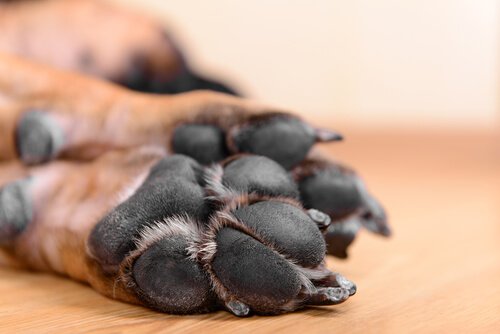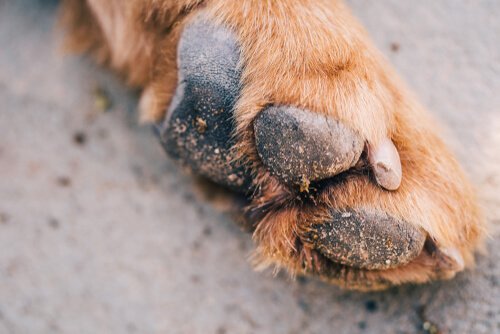Treating Your Dog's Injured Paw Pads

Imagine if you had to walk barefoot everywhere… You’d have to take good care of your feet! The same goes for animals in general, especially for dogs. Therefore, in this article, you can learn how to treat your dog’s injured paw pads.
Why might your dog have injured paw pads?
Many pet owners worry about their animals’ feet and might wonder what could cause injured paw pads. It’s obviously best to prevent injury in the first place. However, if you notice any blood or other signs of injury it’s really important to treat them.
However, before we start, let’s talk a little about your dog’s paw pads, which are a bit like the soles of our shoes. This is the part that makes contact with the ground and helps prevents bone and joint problems. They absorb your dog’s steps and allow them to walk more lightly.
Despite being so resistant, they can also be sensitive and get injured easily. Injured paw pads are more common than you might think. Dogs are often unaware of the risks they take and don’t realize that something might injure them.

Paw pad injuries can be divided into three categories:
1. Injuries caused by erosion
All animals suffer from this due to the wear on the soles of their feet, especially if they walk on cement or other hard surfaces. Excessive and very little exercise can cause erosion too. Although it’s not serious, this type of injury causes more injuries when having contact with the ground.
2. Injuries caused by burns
When it’s very sunny and hot, it’s not a good idea that you take your dog for a walk. Aside from the risk of dehydration (especially with obese or brachycephalic dogs), your dog’s paw pads could burn when they have contact with the hot concrete.
The same goes for the cold and snow, or frozen surfaces. Even breeds which are adapted to live in these climatic conditions, such as the Alaskan Malamute or Siberian Husky, you have to be very careful with their feet on snowy surfaces.
3. Injuries caused by trauma
These sort of injuries include injuries caused by pointy or dangerous objects that can get stuck in your dog’s paws. For example, splinters, sticks, metal, glass, etc. These injuries can cause more serious, painful, bloody wounds. If you don’t treat them quickly, they can cause an infection.
How to treat injured paw pads
Wherever you can, you should try to avoid situations where these types of injury are possible. However, if your dog does have injured paw pads, it’s important to treat them right away. If it’s a small injury, you can probably treat them at home. However, if it’s a serious trauma or your dog can’t walk because of the pain, one way or another, you must go straight to the vet so he/she can check your dog.

Once you’ve noticed an injury or observed that your dog’s paw pads are hard or cracked, follow these steps:
1. Wash with clean water
Often you’ll need to wash the affected area to more serious problems. Lie your dog on his side and wash their paw pads with warm water to remove dirt and help the healing process. This can also be soothing in the case of burns and possible help your dog relax.
2. Trim the surrounding hair
It’s certainly true that the hairs work as a “barrier” against foreign objects that can get stuck in your dog’s paw pads. However, when your dog has injured paw pads, these same hairs can cause infections. It;s recommended that, once you’ve cleaned the affected area, you cut the surrounding hairs because they could be uncomfortable or collect dirt.
3. Wash with oxygenated water
Once the area is clean and you find a wound, — ven if its superficial — it’s important to disinfect it with oxygenated water. Dampen a guaze pad and rub the wound gently. It won’t burn or otherwise have any side-effects for your dog.
4. Apply the right medication
You could ask your vet if you can apply other medications, like diluted iodine or chlorhexidine gluconate. You can get them in a spray and they are easy to use.
If your dog’s injured paw pads are the result of a burn, there are creams and gels you can use to treat them. You may need to cover the paw pads so that the medication doesn’t run off.
Don’t neglect your dog’s injured paw pads because they can be very painful and casue your dog to limp.
This text is provided for informational purposes only and does not replace consultation with a professional. If in doubt, consult your specialist.